Welcome to our article on ornamental grasses that thrive in Zone 4! In this section, we will explore a diverse range of beautiful grass varieties that are specifically suited for gardening enthusiasts living in Zone 4 climates. Whether you’re seeking low-maintenance options or looking to add texture and movement to your garden, we’ve got you covered with these amazing selections.
1. Bottle Brush Grass (Elymus hystrix)
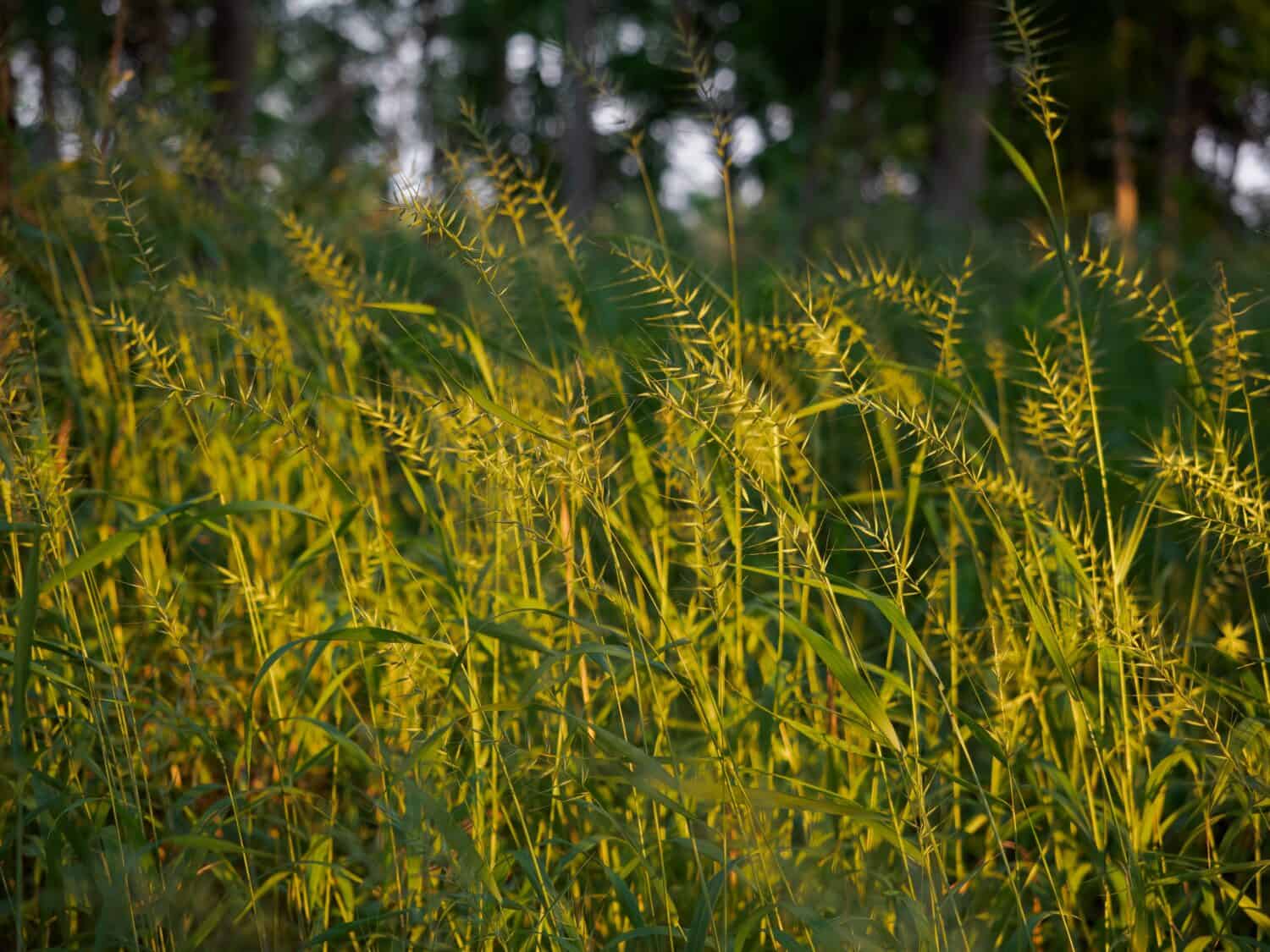
Elymus hystrix is winter hardy in very cold climates.
©Teresa Otto/Shutterstock.com
Bottle brush grass is a clump-forming, cool-season grass that grows in a fountain-like shape. It has narrow, blue-green leaves that arch up and outward, giving it a bottle-brush-like appearance. This grass grows to a height of about 2-3 feet and has a spread of 1-2 feet. It is a great choice for USDA Hardiness Zone 4 as it is cold hardy, and can tolerate temperatures as low as -30°F.
To grow bottle brush grass, plant in full sun to part shade in well-drained soil. Water regularly for the first couple of months to help the plant establish a strong root system. This grass is low maintenance and does not require regular fertilization.
2. Blue Zinger Sedge Grass (Carex flacca)
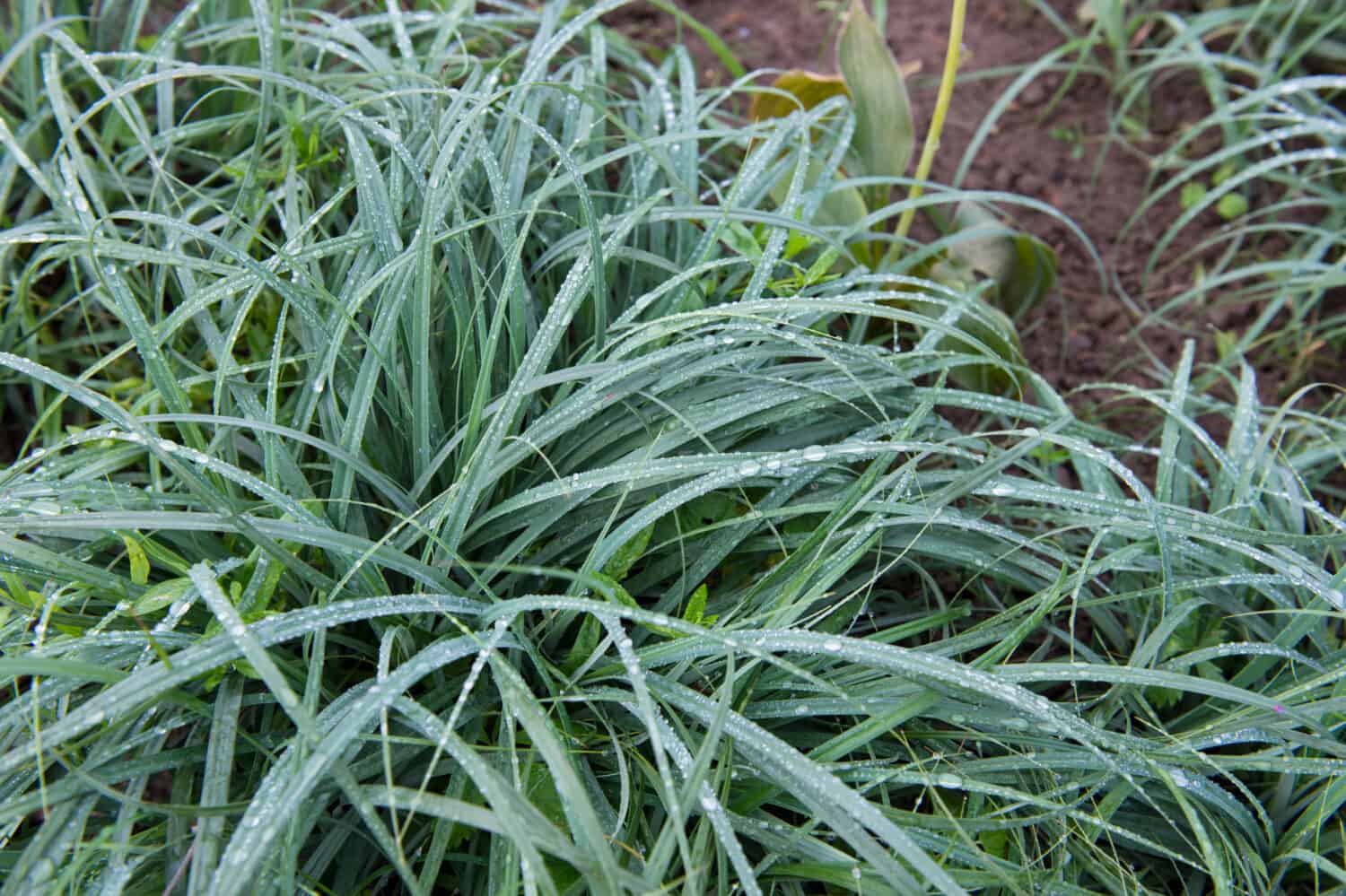
Many of the blue Carex sedge varieties grow quite well in Zone 4.
©Tatyana Mut/Shutterstock.com
Blue Zinger sedge grass is an attractive, clump-forming grass that is popular for its silvery-blue foliage. It can grow up to 12 inches tall and has a spread of 12-18 inches. This grass requires full sun to partial shade and prefers moist, well-drained soils. It is a great choice for USDA Hardiness Zone 4 due to its cold-tolerant nature.
To grow Blue Zinger sedge grass, sow grass seed in the spring when the soil is warm. Plant in an area that gets full sun or partial shade. Make sure the soil is moist and well-drained, and keep the soil consistently moist until the seed germinates. Once the seedlings have emerged, provide regular watering to ensure the grass continues to grow. Fertilize the grass in late spring and again in early summer to encourage growth.
3. Blue Dune Lyme Grass (Leymus Arenarius)
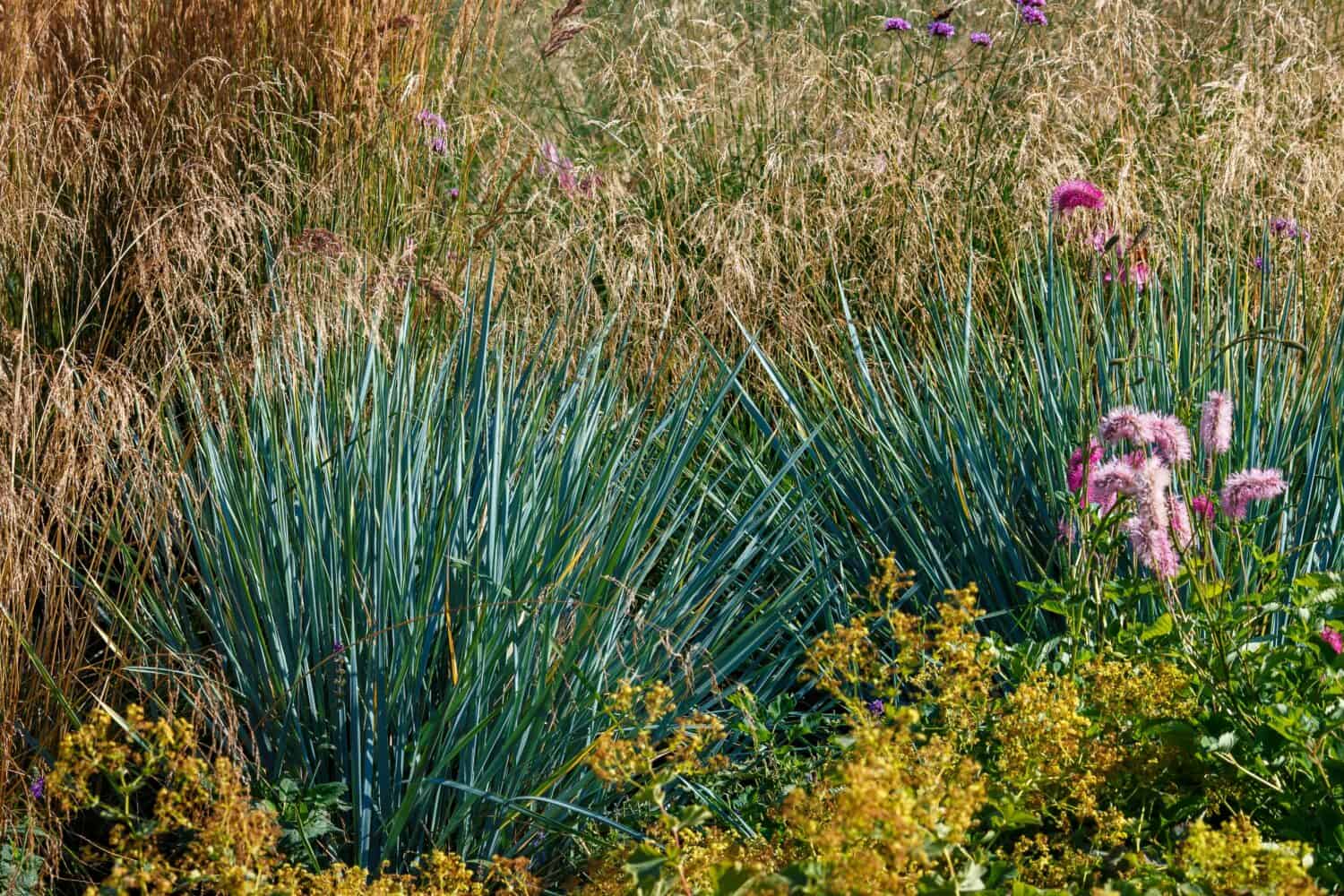
This lovely lyme grass is a great ornamental grass for zone 4.
©Flower_Garden/Shutterstock.com
Blue Dune lyme grass (Leymus arenarius) is a versatile grass with a unique appearance. It has fine, bright blue-green blades with a wispy, drooping habit. It flourishes in full sun and requires well-drained soil for optimal growth.
Blue Dune lyme grass is easy to grow and maintain. It can be planted in the early spring by spreading the seeds and then gently raking the soil to cover them. Once established, the grass should be watered regularly and mowed twice a year to promote healthy growth.
Blue Dune lyme grass is a great choice for USDA Hardiness Zone 4. It is tolerant of cold temperatures and can handle a wide range of soil conditions. It is also drought-tolerant and can thrive in areas with low rainfall. With its low maintenance requirements and attractive appearance, Blue Dune lyme grass is a great choice for a rock garden.
4. Standing Ovation Little Bluestem Grass (Schizachyrium scoparium)
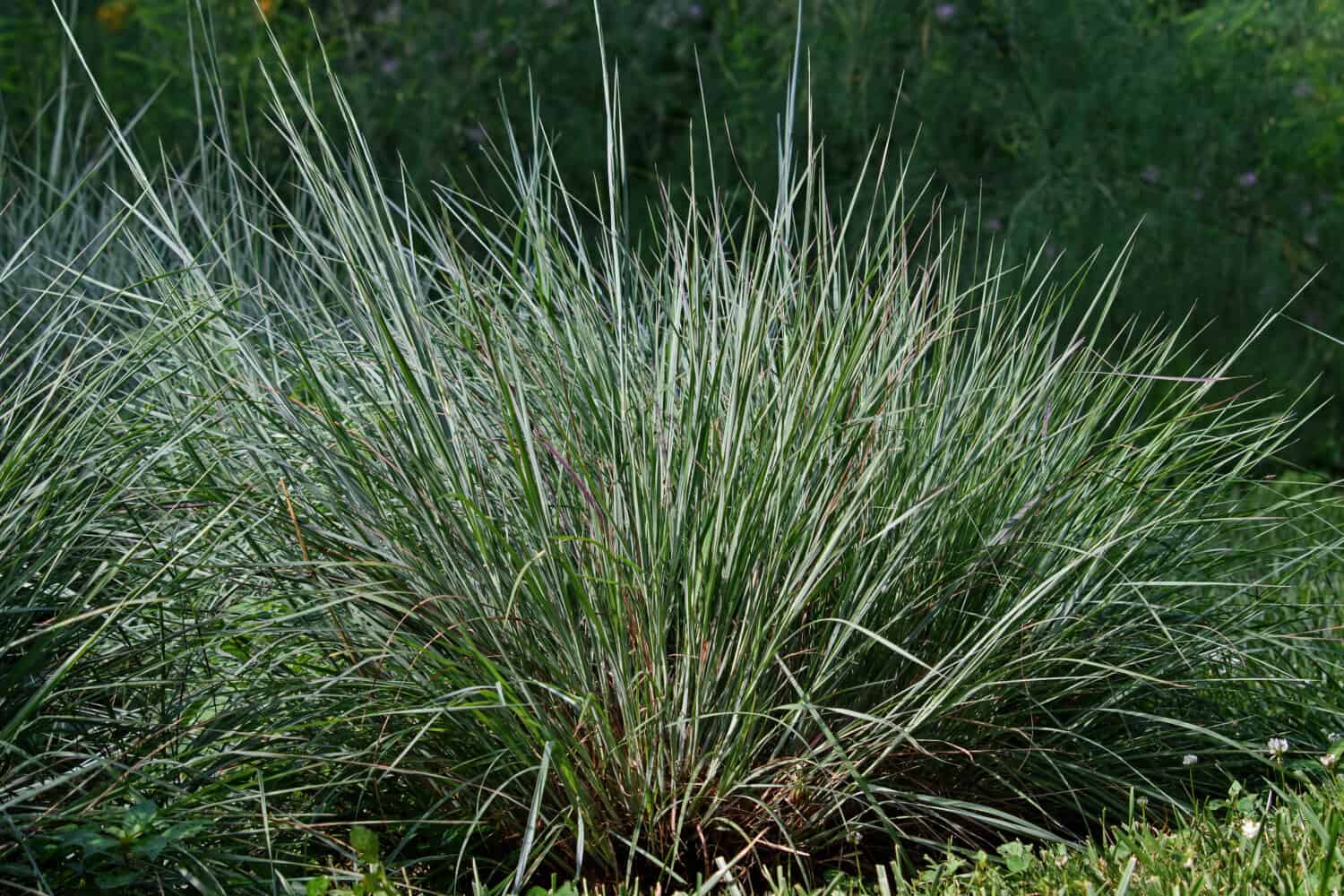
There are many cultivars of bluestem grass that grow well in Zone 4.
©Michael G McKinne/Shutterstock.com
Standing Ovation little bluestem grass is a deciduous grass that is native to North America. It has an upright, clumping form and can grow up to three feet in height. Its foliage is a bright green that turns to shades of yellow, orange, and reddish-purple in the fall. The flower heads are silvery-white and open in August and September.
To grow Standing Ovation little bluestem grass, start by planting in well-drained soil with full-sun exposure. Water deeply and regularly to keep the soil moist until the plant is established. It is important to trim back the foliage in the late fall or early spring to keep the plant looking its best.
This ornamental grass is a great choice for USDA Hardiness Zone 4 due to its ability to withstand cold temperatures. It is also low maintenance and drought tolerant once established. This grass can provide a great source of texture and color to any garden.
5. Blue Grama Grass (Bouteloua gracilis)

When the seedheads first appear on Bouteloua gracilis, they are purple. They are tan after they dry.
©Kathryn Roach/Shutterstock.com
Blue Grama Grass (Bouteloua gracilis) is an attractive grass that has fine-textured blades and a blue-green color. It typically grows in clumps and can reach up to two feet in height. This plant grows beautiful purplish-green flower spikes that are horizontal instead of vertical. This is one of the original prairie grasses that used to thrive all over North America.
To grow Blue Grama Grass, it is best to plant it in well-drained soil and in an area that receives full sun. Water it regularly, and fertilize it once a year.
This ornamental grass is a great choice for USDA Hardiness Zone 4 because it is tolerant of cold temperatures and can withstand harsh climates. It also requires minimal maintenance and is easy to care for. It is a great alternative to regular lawn grass because it naturalizes beautifully.
6. Indian Steel Blue Prairie Grass (Sorghastrum nutans)

Indian Steel Blue prairie grasscomes in a variety of hues.
©Kathryn Roach/Shutterstock.com
Sorghastrum nutans or Indian Steel Blue prairie grass is an attractive, native grass that is known for its steel blue foliage. It typically grows to a height of 2-3 feet and produces a light tan flower in the late summer. The flower head grows taller than the grass and sometimes reaches six feet high. This grass is easy to grow and requires little maintenance, making it a great choice for USDA Hardiness Zone 4.
To grow Indian Steel Blue prairie grass, start by planting the seeds in well-drained soil. Make sure to space the seeds 4-6 inches apart and cover them lightly with soil. Water regularly and keep the soil moist until the seeds have germinated. Once the grass starts to grow, it can tolerate more drought conditions and can thrive with minimal watering. It is drought-tolerant and can survive temperatures as low as -30 degrees Fahrenheit. It also doesn’t require much maintenance and can grow in full sun or partial shade. With its attractive steel blue foliage and low maintenance, it is a great choice for any garden.
7. Big Bluestem Grass (Andropogon Gerardii)

The flower cluster of a stem of big bluestem (Andropogon gerardi) is attractive to birds.
©Nancy Bauer/Shutterstock.com
Big Bluestem grass (Andropogon gerardii) is a beautiful, tall grass that is native to North America. It has a striking blue-green color, with a red tinge in the late summer and fall. The leaves are flat and grow to 3-6 feet in height. This grass is a great choice for USDA Hardiness Zone 4, as it can tolerate cold temperatures and is drought tolerant.
Big Bluestem grass can grow in a variety of soils but does best in well-drained soils. It prefers full sun but will tolerate partial shade. It’s best to plant the grass in the spring, and it should be watered regularly during the first growing season. For best results, use a slow-release fertilizer to promote healthy growth. Once established, Big Bluestem grass is low maintenance and only needs to be mowed occasionally.
It’s also a great choice for areas that need erosion control, as its deep roots help to stabilize the soil. The grass provides food and shelter for wildlife, and its tall stalks can be a beautiful addition to any garden.
8. Tufted Hair Grass (Deschampsia cespitosa)
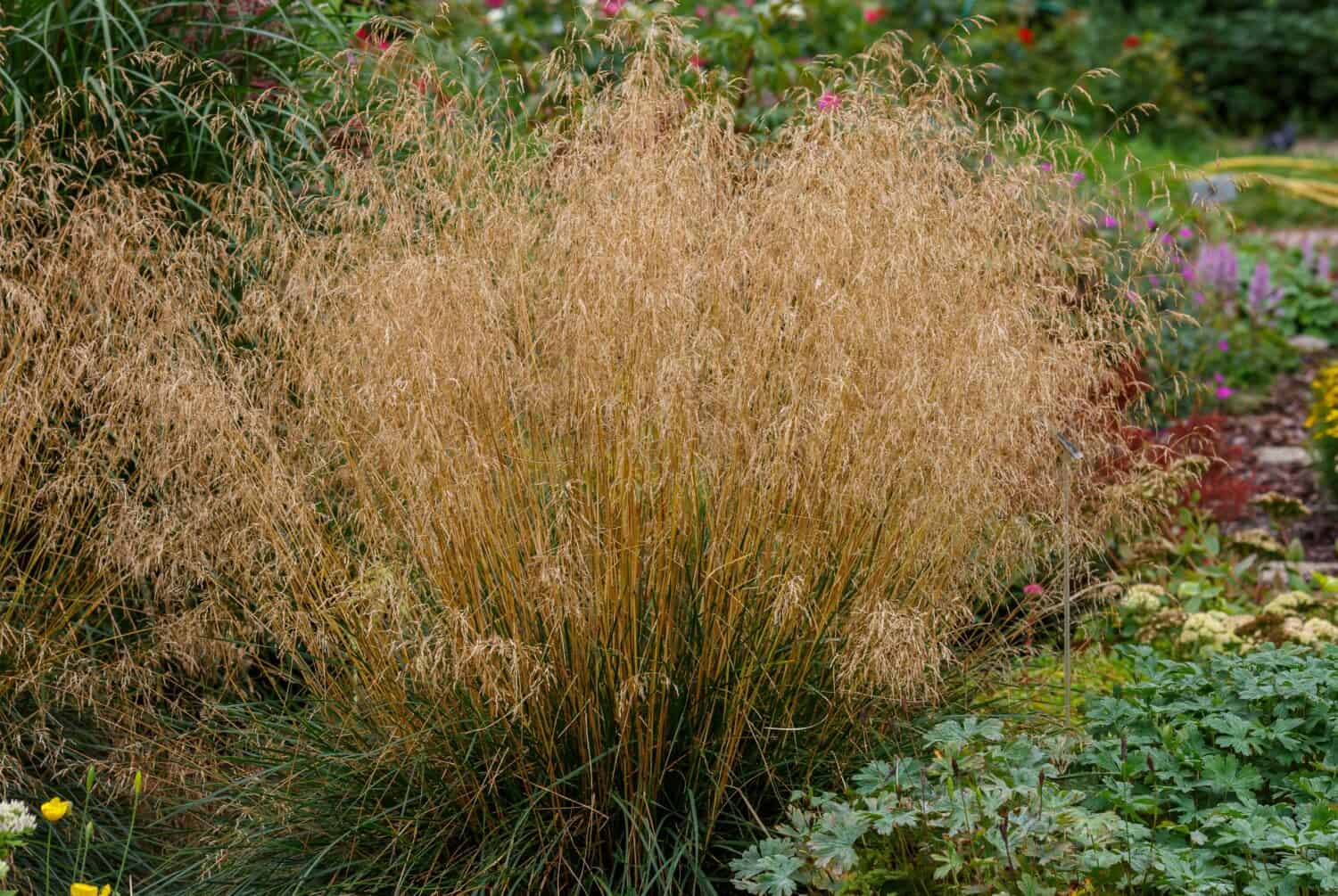
This ornamental grass has many common names, including pike grass and tufted hair grass.
©Flower_Garden/Shutterstock.com
Tufted hair grass is an ornamental grass from the Poaceae family with narrow, green leaves that form in tufts and small flowers that appear in early summer. It grows best in moist soils and prefers full sun to partial shade. This ornamental grass is a good choice for zone 4 because it is very winter hardy and can tolerate temperatures as low as -30°F (-34°C).
To grow, make sure to plant it in well-draining soil. Water regularly and fertilize during the growing season to promote healthy growth. Tufted Hair Grass will spread rapidly, so it is important to keep it trimmed back and divide the clumps every few years. Pruning should be done in late winter or early spring before the new growth appears.
9. Porcupine Zebra Grass (Miscanthus sinensis ‘Stricus’)
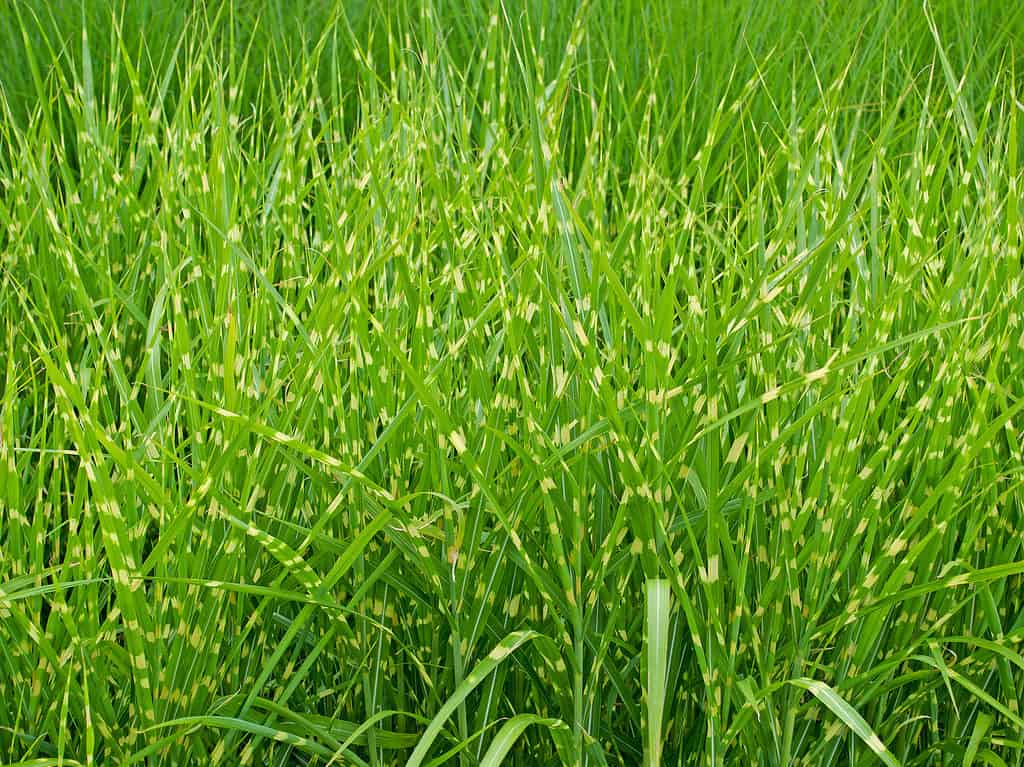
Miscanthus sinensis ‘Stricus’ is a low-maintenance ornamental grass for Zone 4.
©M. Schuppich/Shutterstock.com
Porcupine zebra grass is a striking ornamental grass with unique foliage. It has long, narrow, variegated leaves with white mid-rib and green margins. These leaves are topped with showy, fluffy plumes in the fall. Growing to a height of 4-5 feet and a width of 2-3 feet, this grass is a great choice for adding interest and texture to gardens in Zone 4.
To grow porcupine zebra grass, it is best to plant in full sun in soil that has been amended with compost. The plant should be watered regularly until established. Then, it is somewhat drought tolerant. Dead foliage should be removed in late winter or early spring, and the plant should be divided every three to five years to maintain health and vigor.
10. Heavy Metal Switch Grass (Panicum virgatum)
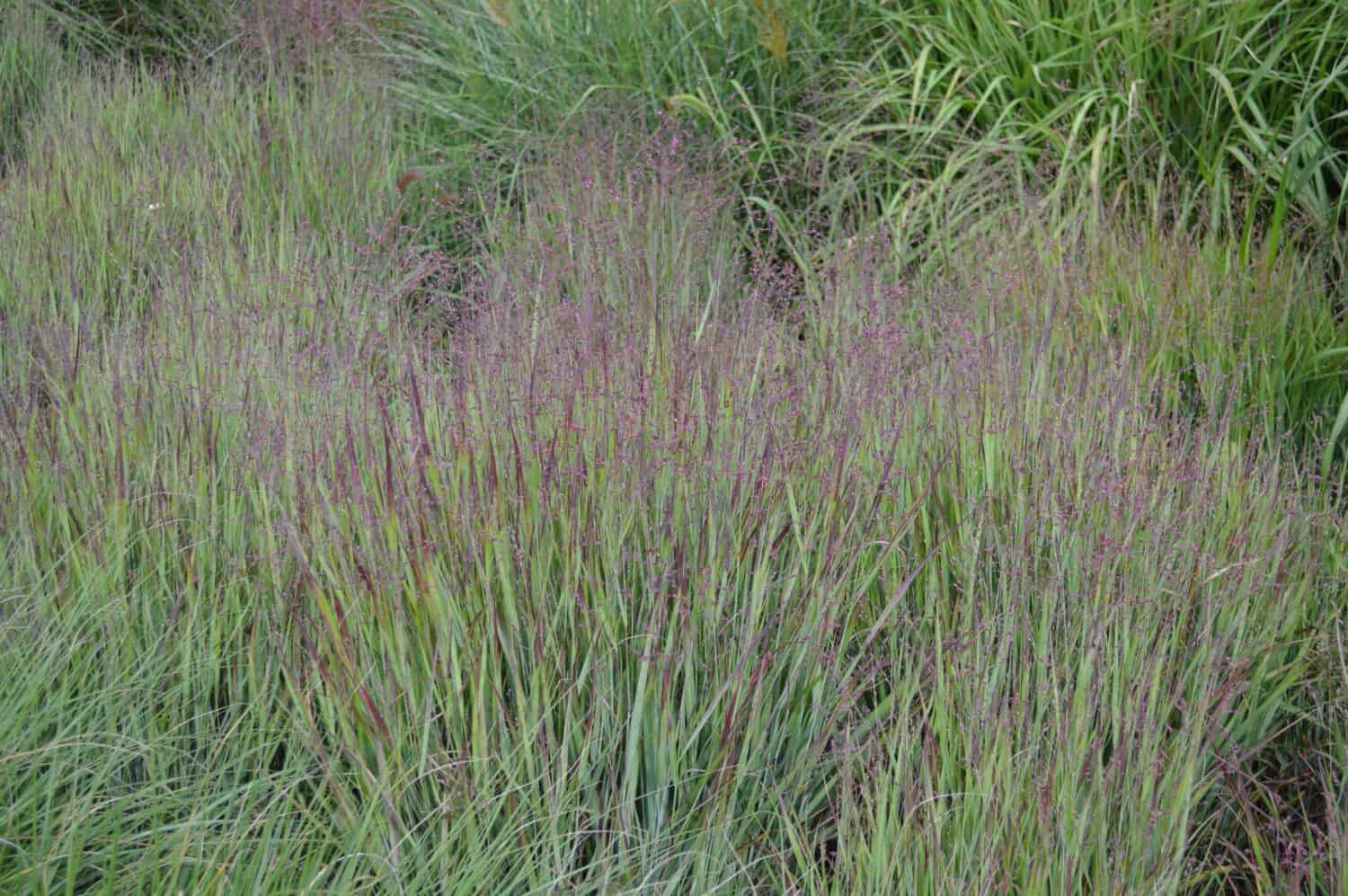
The metallic purple hue of this ornamental grass makes it look like smoke from far away.
©Joe Kuis/Shutterstock.com
Heavy metal switch grass is a popular ornamental grass with attractive, deep blue-green foliage and robust habit. This grass can grow up to 4-5 feet tall and has a clumping habit. It is tolerant of a wide variety of soils and is a good choice for Zone 4.
Heavy metal switch grass is a relatively easy grass to grow. It prefers full sun and moist soil but can tolerate some drought. Plant the grass in spring or fall in well-draining soil and space the plants 2-3 feet apart. Once established, the grass requires minimal maintenance. It also spreads slowly, forming clumps and adding texture to the landscape.
11. Fire Dragon Maiden Grass (Miscanthus)

There are many types of Miscanthus, including those with red blades of grass and those with green like this one.
©Wut_Moppie/Shutterstock.com
Fire Dragon maiden grass (Miscanthus) is an ornamental grass that is known for its vibrant colors. It has deep red foliage with tall, silvery-white plumes that bloom in late summer. The plant grows best in full sun and requires regular watering. It can grow up to 5 feet tall and 3 feet wide.
Miscanthus is a great choice for gardeners in zones 4-8. It is hardy and adapts well to a variety of soil conditions. This grass is also drought-tolerant and can be grown in a container if needed. It is a low-maintenance plant that does not require much fertilizer or pruning.
Overall, Fire DragonmMaiden grass (Miscanthus) is an attractive and low-maintenance ornamental grass for gardeners in Zone 4. It adds a unique texture and color to any landscape and is easy to grow and maintain.
12. Cloud Nine Switch Grass (Panicum Virgatum)
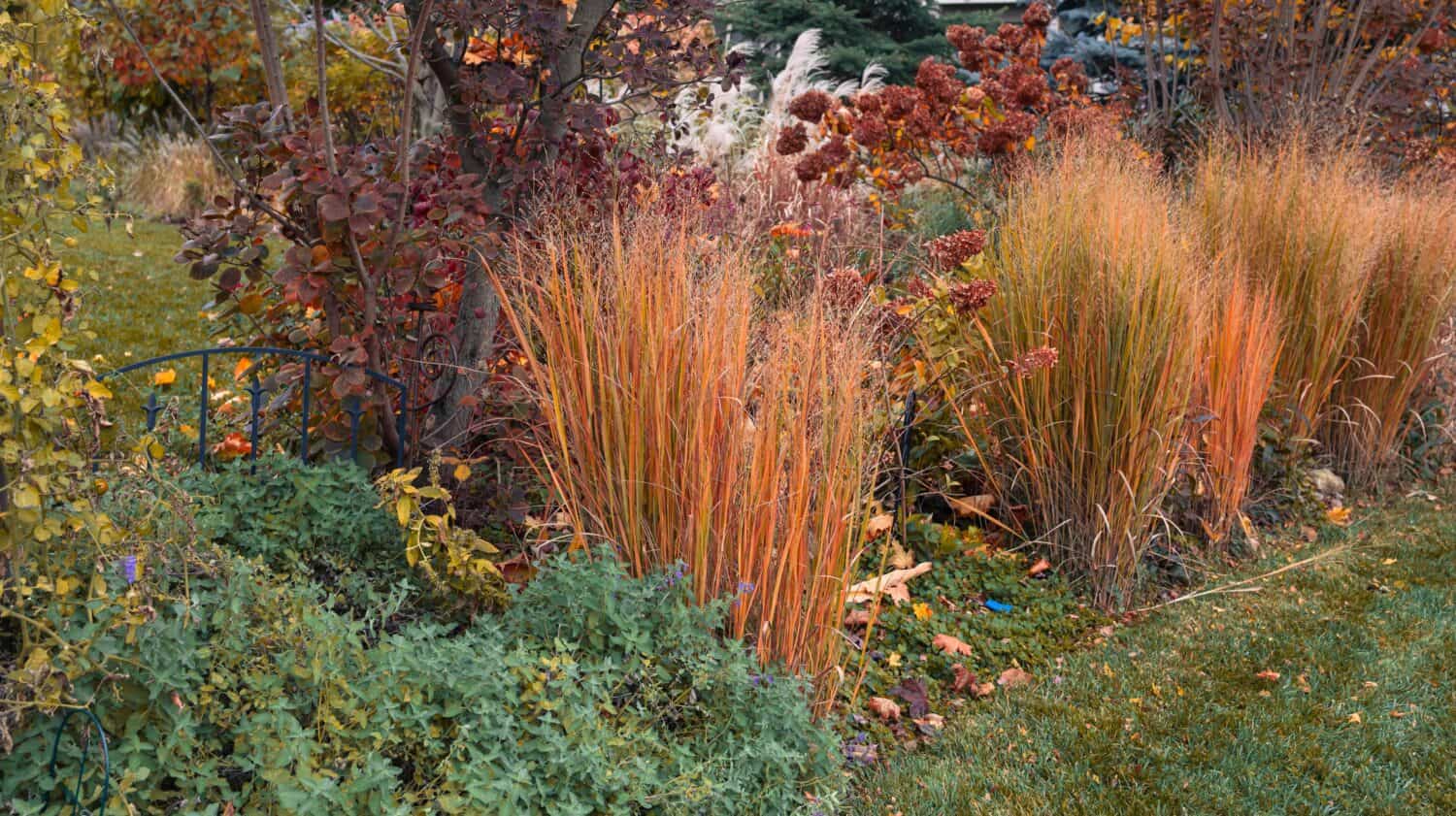
There is a type of switchgrass for every garden.
©Molly Shannon/Shutterstock.com
Cloud Nine switch grass is an attractive perennial grass with a blue-green hue and long, narrow leaves. It grows to a height of 3-5 feet and produces an airy, reddish-purple flower in late summer. This versatile grass is a great choice for Zone 4 gardens, as it is hardy and can tolerate cold temperatures.
Cloud Nine switch grass is easy to grow and requires little maintenance. Plant it in an area with full sun, in soil that is well-draining and rich in organic matter. Water it regularly during the first growing season to help it establish a strong root system. Once established, it is drought tolerant and requires little additional watering.
13. Blue Fescue (Festuca glauca)

The lovely blue blades of Festuca glauca are a delight to grow.
©Martina Unbehauen/Shutterstock.com
Blue fescue is an ornamental grass with a unique appearance. It has an upright clump-forming habit, and its thin blue-green leaves are 2-3 inches long. It produces a silvery-blue flower spike in late spring.
Blue fescue is easy to grow and thrives in full sun and well-drained soil. It’s drought tolerant and can tolerate some shade, but it needs adequate moisture during the growing season. It’s a low-maintenance plant that requires little pruning or fertilizing.
Blue Fescue is a great choice for Zone 4. It’s hardy enough to withstand cold winters and can be grown in areas with temperatures as low as -30 degrees Fahrenheit. It’s also low-maintenance and drought-tolerant, making it a great choice for those who don’t want to spend a lot of time and energy caring for their plants.
14. Autumn Moor Grass (Sesleria autumnalis)

The tasty seeds of autumn moor grass will cause birds to flock to your garden.
©Flower_Garden/Shutterstock.com
Autumn moor grass (Sesleria autumnalis) is an ideal choice for those looking for hardy, low-maintenance grass in Zone 4. It is a clump-forming, cool-season grass that has tufts of blue-green foliage with a silvery sheen. In the late summer, it produces purple-tinged flower spikes that turn reddish-brown in the autumn.
Autumn moor grass is easy to grow and requires little maintenance. It prefers full sun to partial shade and soil that is moist but well-drained. It is winter-hardy down to -30 degrees Fahrenheit and can be propagated easily by division or seed.
15. Big Twister Giant Corkscrew Rush (Juncus effusus)

This is one of those ornamental grasses that look stunning in a container.
©Modest Things/Shutterstock.com
Big Twister giant corkscrew rush is a species of rush that is native to North America. It is known for its tall, graceful stems and its spiraling seed heads. The stems reach up to 5 feet in height, and the seed heads can be 4 to 6 inches long. The stems are green, and the seed heads are silvery-white in color.
This ornamental grass is easy to grow and will thrive in moist soils, in full sun or partial shade. Corkscrew rush can also tolerate slightly alkaline soils. It can be grown from seed or division and will spread and create an attractive ground cover over time. It looks especially beautiful in a container or planted near the edge of a pond.
16. Dwarf Horsetail Reed Grass (Equisetum scirpoides)
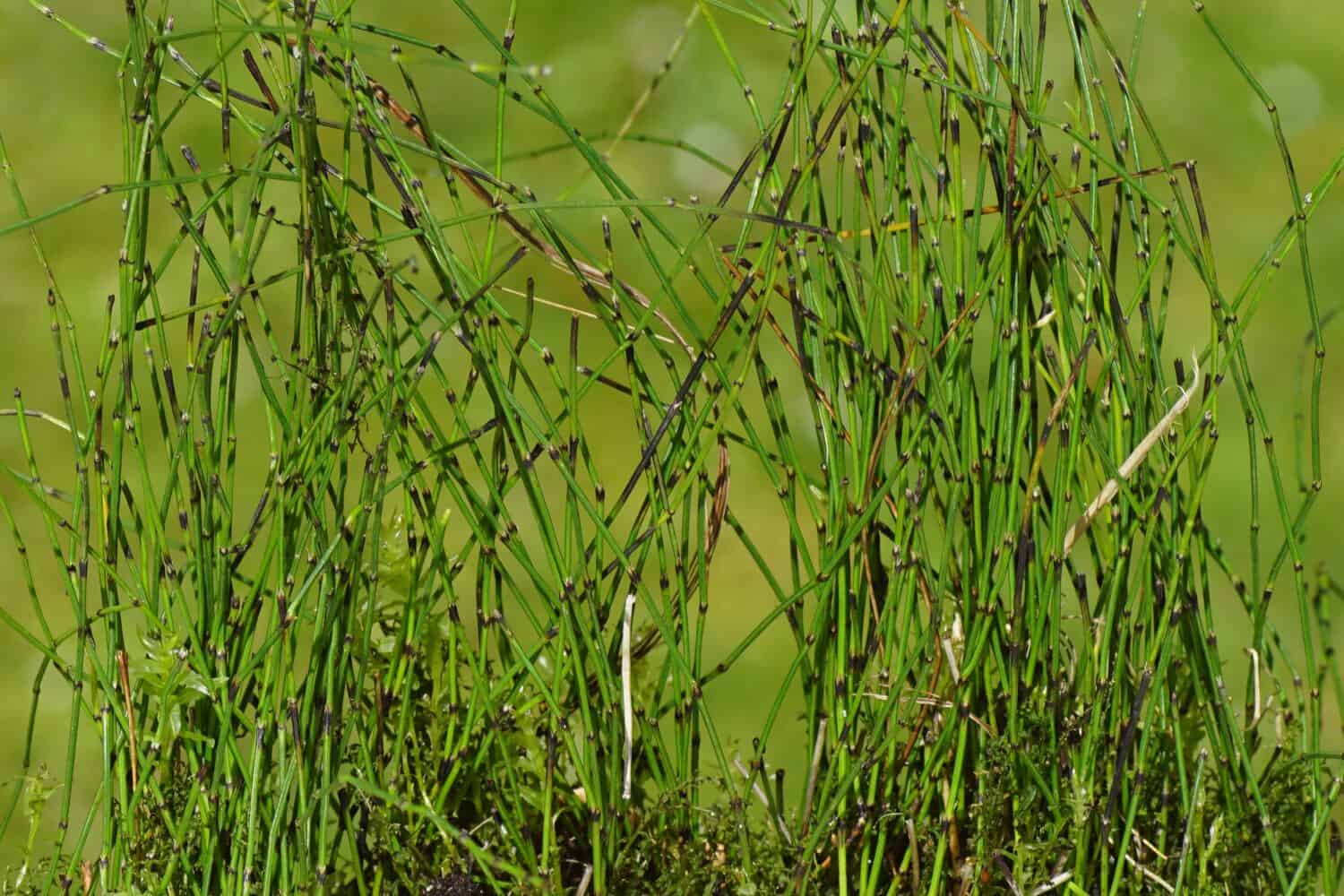
Horsetail grass grows very well in moist and shady gardens.
©Thijs de Graaf/Shutterstock.com
Dwarf horsetail reed grass (Equisetum scirpoides) is an attractive and hardy perennial with many benefits. It has tall, narrow, bright green stems and delicate branches that bear small, conelike strobili. This grass can grow up to 3 feet tall and is a great choice for zones 4-9.
Growing dwarf horsetail reed grass is easy. It prefers partial shade to full sun and consistently moist soil. To plant, sow the seeds in a shallow trench and cover lightly with soil. Water regularly and keep the area free of weeds. It looks awesome in a container or water garden and resembles miniature bamboo.
Summary of 16 Ornamental Grasses That Thrive in Zone 4
| Grass | Scientific Name | |
|---|---|---|
| 1 | Bottle Brush Grass | Elymus hystrix |
| 2 | Blue Zinger Sedge Grass | Carex flacca |
| 3 | Blue Dune Lyme Grass | Leymus Arenarius |
| 4 | Standing Ovation Little Bluestem Grass | Schizachyrium scoparium |
| 5 | Blue Grama Grass | Bouteloua gracilis |
| 6 | Indian Steel Blue Prairie Grass | Sorghastrum nutans |
| 7 | Big Bluestem Grass | Andropogon Gerardii |
| 8 | Tufted Hair Grass | Deschampsia cespitosa |
| 9 | Porcupine Zebra Grass | Miscanthus sinensis ‘Stricus’ |
| 10 | Heavy Metal Switch Grass | Panicum virgatum |
| 11 | Fire Dragon Maiden Grass | Miscanthus |
| 12 | Cloud Nine Switch Grass | Panicum Virgatum |
| 13 | Blue Fescue | Festuca glauca |
| 14 | Autumn Moor Grass | Sesleria autumnalis |
| 15 | Big Twister Giant Corkscrew Rush | Juncus effusus |
| 16 | Dwarf Horsetail Reed Grass | Equisetum scirpoides |
The photo featured at the top of this post is © Molly Shannon/Shutterstock.com
Thank you for reading! Have some feedback for us? Contact the AZ Animals editorial team.







